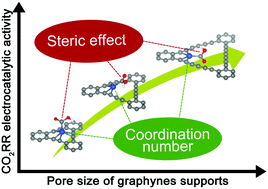Pore size effect of graphyne supports on CO2 electrocatalytic activity of Cu single atoms†
Abstract
The instinctive chemical inertia of CO2 impedes its electrochemical reduction by high energy input. Single atom catalysts (SACs) on supports are considered as a class of excellent electrocatalysts with high activity, selectivity and atomic efficiency for CO2 electrochemical reduction. Supports for single atoms are believed to greatly impact the electrocatalytic activity of SACs. However, further research on the relationship between the structure of supports for SACs and CO2 electroreduction is still needed. Herein, density functional theory (DFT) calculations are performed to investigate the role of supports in tuning the CO2 electrocatalytic activity of SACs. Graphynes with different pore sizes (graphyne, graphdiyne, graphyne-3 and graphyne-4) are taken into account to unveil the effect of their skeleton structure on the anchored Cu single atoms. We found that support skeletons could greatly impact the coordination configuration of metal atoms and the steric repulsion of support skeletons to intermediates. These two factors jointly result in different electrocatalytic performances of SACs. The comparative analysis proves that the graphynes with large pores are appropriate supports for Cu adatoms for CO2 electroreduction due to the low-coordinated Cu atoms and weak-steric-repulsion carbon skeleton. Such SACs exhibit much enhanced activity and selectivity as compared with the Cu(111) surface and monoatomic Cu on nitrogen-doped graphene. This work provides a new insight into the rational design of supports for SACs.



 Please wait while we load your content...
Please wait while we load your content...